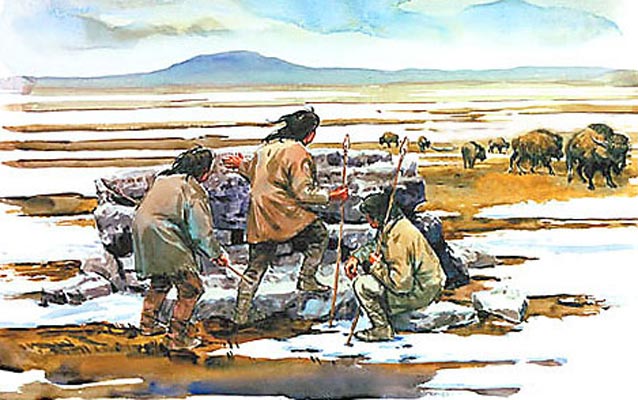Last updated: May 21, 2015
Lesson Plan
North American Indian Migration into North Dakota

- Grade Level:
- Upper Elementary: Third Grade through Fifth Grade
- Subject:
- Social Studies
- Lesson Duration:
- 60 Minutes
- Common Core Standards:
- 4.RI.2
- State Standards:
- State: North Dakota
Subject: History
Grade Level: Fourth Grade
State Standards: 4.1.1, 4.2.6, 4.2.7, 4.2.9, 4.2.10, 4.3.2, 4.5.1, 4.5.3 - Thinking Skills:
- Understanding: Understand the main idea of material heard, viewed, or read. Interpret or summarize the ideas in own words. Applying: Apply an abstract idea in a concrete situation to solve a problem or relate it to a prior experience. Analyzing: Break down a concept or idea into parts and show the relationships among the parts. Creating: Bring together parts (elements, compounds) of knowledge to form a whole and build relationships for NEW situations.
Objective
In this lesson, students will compare and contrast the Great Plains and the Central Lowlands. Then, students will identify different tribal territories on maps. By the end of the lesson, students will answer the following essential question: How did the different climate regions of North Dakota influence Indian cultures in those regions?
Background
This lesson puts the Assiniboine in a geographical context for further lessons about Assiniboine culture and the fur trade.
Preparation
-
Make enough copies of “North American Indian Migration Sources” packet so that each group of two or three students has a copy.
-
Make each student a copy of “North American Indian Migration Student Materials” packet.
-
Print off the “North American Indian Migration Teacher Guide” for an answer key.
- If desired, choose groups for students, possibly mixed-ability.
Materials
Students will learn the content through these sources.
Download North American Indian Migration Sources
These are questions that students will answer based on the sources.
Download North American Indian Migration Student Materials
This will include answers to the student materials questions.
Download North American Indian Migration Teacher Guide
Lesson Hook/Preview
-
Ask students: “If you were moving from Florida to Alaska, what challenges would you face? How could you overcome those challenges? “
- Explain to students that today they will be learning about reasons why Native Americans moved from the Great Lakes region of Minnesota to the Great Plains of North Dakota.
Procedure
-
Put students in small groups of two or three. Hand out to each group a sources packet. Hand out to each student a student materials packet.
-
Read the introduction out loud with the students.
-
Then, ask the students to read and complete questions for source 1.
-
Go over the answers with the students using “Teacher Key”.
-
Then, ask students to learn about North Dakota climate and illustrate that climate using source 2 reading and questions. Tell students that when they are finished, they should continue with the bottom half of the page by predicting based on the climate the different lifestyles Native Americans would have in the different climates.
-
Ask students to share their predictions. Then, read source 3 on “Migration from East to West” to check their predictions.
-
Explain to students that now that they understand the climate of North Dakota and how that climate influences Native American lifestyle, they will get to research a specific tribe. Put students into new groups based on what region the students would like to research.
-
The students should use source 4 to complete their research questions independently or in small groups.
Vocabulary
-
Acute angle: an angle that is less than 90 degrees
-
Culture: a shared system of behaviors, attitudes, and understandings.
-
Escarpment: a long cliff or steep slope separating two comparatively level or more gently sloping surfaces and resulting from erosion or faulting.
-
Glaciers: series of continental ice sheets
-
Migrate: to move to a new area
-
Nomadic: describing people who have no permanent home but move from place to place, as in hunters who follow buffalo herds.
-
Society: a large group of people who live in a particular place, speak a common language, and share interests, relationships, basic beliefs and social identity.
-
Tipis: transportable shelters made out of buffalo hides or canvas.
- Travois: two large poles attached together at one end creating an acute angle. This end was latched to a dog or horse. A laced circular platform (like a snowshoe) between the two long poles held tipi or earth lodge furnishings or a tipi.
Assessment Materials
Journal EntryTo show their understanding of Native American lifestyle due to the Great Plains climate, students will be writing a journal entry. The directions for this journal are the last question in the student materials packet.
Supports for Struggling Learners
-
Mixed ability groups to complete research
- Read text out loud as a group prior to independent completion of the questions
Enrichment Activities
Students can continue research of their tribe by focusing on the tribe in current day. Possible sources include Department of Indian Affairs http://www.bia.gov/ and the National Museum of American Indian http://nmai.si.edu/home/
Additional Resources
Dakota, S. H. (n.d.). Mandan, Hidatsa, and Sahnish. Retrieved 9 3, 2013, from North Dakota Studies: http://ndstudies.gov/threeaffiliated_historical_overview
Denig, E. T. (1961). Five Indian Tribes of the Upper Missouri. Norman: University of Oklahoma Press.
Holmes, K. (2008). Montana: Stories of the Land. Helena: Montana Historical Society Press.
Kennedy, M. S. (1961). The Assiniboines. Norman: Univeristy of Oklahoma Press.
Robinson, E. B. (1995). History of North Dakota. Fargo: North Dakota State University.
